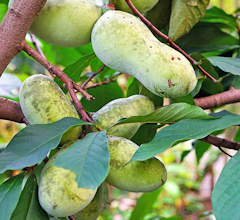Paw Paw Leaf
 Paw Paw (Asimina triloba) is a small deciduous tree that grows in well-drained upland habitats and is native to the Eastern United States and Canada. The tree produces large leaves and yellowish-green fruits with a sweet, delectable flavour.
Paw Paw (Asimina triloba) is a small deciduous tree that grows in well-drained upland habitats and is native to the Eastern United States and Canada. The tree produces large leaves and yellowish-green fruits with a sweet, delectable flavour.
While the fruit is widely used for food, the tree leaves contain many phytochemicals including acetogenins, annonacin, and asimitrin. The leaves of the Paw Paw also contain soluble fibre and enzymes known as papain, that possesses significant medicinal properties.
Paw Paw is also rich in Vitamins A, B, C, D and E.
Health Benefits of Paw Paw Leaf
Paw Paw leaves have been found to therapeutically possess antibacterial, analgesic, anti-tumor, vermifuge, anti-inflammatory, digestive, and anti-oxidant characteristics. Following are the details of some of the health benefits of Paw Paw leaves based on scientific findings:
- Anti-Cancer Effects
Products that contain Paw Paw leaves are widely consumed as anti-cancer alternative medicines. According to some studies, acetogenins in Paw Paw supplements or remedies, may help suppress tumor cells.1
Some other studies confirm that acetogenin may be responsible for the anti-proliferative activity of Paw Paw Leaf, and therefore the use of this herb may have a significant role in cancer prevention and treatment. The use of Paw Paw Leaves, being a naturally derived substance, may also be less toxic than the use of conventional chemotherapy drugs in the treatment of cancer.2
- Antibacterial Activity
The phytochemical components of Asimina triloba, contained in Paw Paw Leaf, showed the presence of alkaloids and phlobatanin. These components have been known to assist in combatting bacterial activity and infections and also possess protective properties against fungal infections. According to clinical findings, alkaloids and phlobatanin usually prevent the growth and metabolisms of harmful microorganisms.3
In addition, Paw Paw Leaves may be used in the treatment of cuts, rashes, stings and burns.3
- Antioxidant Effects
Free radicals cause cellular damage and can result in the development of cancer and other diseases. Free radicals are also responsible for ageing. Asimina triloba essential oil, extracted from Paw Paw Leaves, has a significant capacity to eliminate free radicals in the body and neutralise their harmful effects. This antioxidant activity is likely associated with the presence of compounds such as farnesol, alpha-humulene, and linalool found in Paw Paw leaves.4 - Skin Health and Maintenance
Paw Paw Leaves consist of many bioactive compounds that are beneficial for skin health. The use of Paw Paw Leaves has been found to be beneficial in the treatment of eczema, warts, and rashes.5
The enzyme papain, found in Paw Paw Leaves, may also help to remove dead skin cells, making skin smooth and young.6
Vitamin C, found in Paw Paw Leaves, helps to protect skin against sun damage and due to a number of other minerals and vitamins it contains, helps to keep skin moisturised, reduces wrinkles, and unclogs pores. Skin products containing Paw Paw Leaf are also excellent for people prone to acne. Paw Paw Leaves act as a good bleaching agent and are an essential ingredient in bath soaps, astringents, detergent bars and hand washes.5
- Help With Digestive Issues
The leaves of Paw Paw plants contain the chemical compounds of karpain, which may kill microorganisms that often interfere negatively with a person’s digestive function.5 - Anti-Malarial and Anti-Plasmodial Activity
Paw Paw Leaves, when added to tea or used as a powdered herb, have been found to be an effective treatment for malaria. The anti-malarial and anti-plasmodial activity has been noted in some preparations of the plant, but the mechanism is not yet scientifically studied and fully understood.5
Side Effects of Paw Paw Leaf
Paw Paw Leaf is relatively safe to use if applied to the skin. The only exception, is people sensitive to Paw Paw bioactive compounds, as the usage of leaf extract can cause redness, itchy rashes, and some inflammatory reactions.
When taken orally, the use of Paw Paw Leaves can cause some mild side effects like vomiting, nausea, rash, and itching.
As there isn’t sufficient data on the safety of Paw Paw Leaf in pregnant women, it is recommended to avoid the products containing Paw Paw Leaves while pregnant.
Properties
- Anti-Bacterial3
- Anti-Fungal3
- Anti-Inflammatory4
- Anti-Parasitic5
- Antioxidant4
- Antiviral4
- Cancer Prevention1,2
- Digestive Function5
- High/Good Levels of B Vitamins4
- High/Good Levels of Phytochemicals / Phytocompounds3,4
- High/Good Levels of Vitamin A3,4
- High/Good Levels of Vitamin C3,4
- High/Good Levels of Vitamin D3,4
- High/Good Levels of Vitamin E3,4
- Immune Booster4
- Malaria Support5
- Skin Issues5,6
- Wound Healing5,6
References:
- Coothankandaswamy V, Liu Y, Mao S-C, et al. The Alternative Medicine Pawpaw and Its Acetogenin Constituents Suppress Tumor Angiogenesis via the HIF-1/VEGF Pathway. J Nat Prod. 2010;73(5):956-961. doi:10.1021/np100228d
- Nam J-S, Park S-Y, Lee H-J, Lee S-O, Jang H-L, Rhee YH. Correlation Between Acetogenin Content and Antiproliferative Activity of Pawpaw (Asimina triloba [L.] Dunal) Fruit Pulp Grown in Korea. J Food Sci. 2018;83(5):1430-1435. doi:10.1111/1750-3841.14144
- Alabaka M, Oyewole O. Antibacterial Activities of Asmina triloba against Some Bacterial Pathogens. J Microbiol Res. 2011;1(1):5-7.
- Farag MA. Chemical composition and biological activities of Asimina triloba leaf essential oil. Pharm Biol. 2009;47(10):982-986. doi:10.1080/13880200902967995
- Aravind G, Bhowmik Debjit, Duraivel S, Harish G. Traditional and Medicinal Uses of Carica papaya. J Med Plants Stud. 2013;1(1):07-15.
- Brannan RG, Peters T, Talcott ST. Phytochemical analysis of ten varieties of pawpaw (Asimina triloba [L.] Dunal) fruit pulp. Food Chem. 2015;168:656-661. doi:10.1016/j.foodchem.2014.07.018
